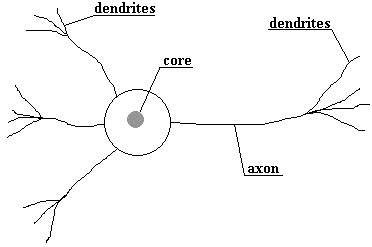The biological model: The human brain
The human brain consists of a large number (more than a billion) of neural cells that process information. Each cell works like a simple processor and only the massive interaction between all cells and their parallel processing makes the brain's abilities possible.
Below you see a sketch of such a neural cell, called a neuron:

- Structure of a neural cell in the human brain
As the figure indicates, a neuron consists of a core, dendrites for incoming information and an axon with dendrites for outgoing information that is passed to connected neurons.
Information is transported between neurons in form of electrical stimulations along the dendrites.
Incoming informations that reach the neuron's dendrites is added up and then delivered along the neuron's axon to the dendrites at its end, where the information is passed to other neurons if the stimulation has exceeded a certain threshold. In this case, the neuron is said to be activated.
If the incoming stimulation had been too low, the information will not be transported any further. In this case, the neuron is said to be inhibited.
The connections between the neurons are adaptive, what means that the connection structure is changing dynamically. It is commonly acknowledged that the learning ability of the human brain is based on this adaptation.

